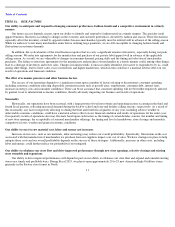American Eagle Outfitters 2014 Annual Report Download - page 21
Download and view the complete annual report
Please find page 21 of the 2014 American Eagle Outfitters annual report below. You can navigate through the pages in the report by either clicking on the pages listed below, or by using the keyword search tool below to find specific information within the annual report.
Table of Contents
reported financial condition and results of operations should actual results differ from these estimates. We base our estimates and assumptions
on the best available information and believe them to be reasonable for the circumstances. We believe that of our significant accounting
policies, the following involve a higher degree of judgment and complexity. Refer to Note 2 to the Consolidated Financial Statements for a
complete discussion of our significant accounting policies. Management has reviewed these critical accounting policies and estimates with the
Audit Committee of our Board.
Revenue Recognition. We record revenue for store sales upon the purchase of merchandise by customers. Our e-commerce operation
records revenue upon the estimated customer receipt date of the merchandise. Revenue is not recorded on the purchase of gift cards. A current
liability is recorded upon purchase, and revenue is recognized when the gift card is redeemed for merchandise.
We estimate gift card breakage and recognize revenue in proportion to actual gift card redemptions as a component of total net revenue.
We determine an estimated gift card breakage rate by continuously evaluating historical redemption data and the time when there is a remote
likelihood that a gift card will be redeemed.
Revenue is recorded net of estimated and actual sales returns and deductions for coupon redemptions and other promotions. The
estimated sales return reserve is based on projected merchandise returns determined through the use of historical average return percentages.
We do not believe there is a reasonable likelihood that there will be a material change in the future estimates or assumptions we use to calculate
our sales return reserve. However, if the actual rate of sales returns increases significantly, our operating results could be adversely affected.
We recognize royalty revenue generated from our license or franchise agreements based upon a percentage of merchandise sales by the
licensee/franchisee. This revenue is recorded as a component of total net revenue when earned.
Merchandise Inventory. Merchandise inventory is valued at the lower of average cost or market, utilizing the retail method. Average
cost includes merchandise design and sourcing costs and related expenses. We record merchandise receipts at the time which both title and risk
of loss for the merchandise transfers to us.
We review our inventory in order to identify slow-
moving merchandise and generally use markdowns to clear merchandise. Additionally,
we estimate a markdown reserve for future planned markdowns related to current inventory. If inventory exceeds customer demand for reasons
of style, seasonal adaptation, changes in customer preference, lack of consumer acceptance of fashion items, competition, or if it is determined
that the inventory in stock will not sell at its currently ticketed price, additional markdowns may be necessary. These markdowns may have a
material adverse impact on earnings, depending on the extent and amount of inventory affected.
We estimate an inventory shrinkage reserve for anticipated losses for the period between the last physical count and the balance sheet
date. The estimate for the shrinkage reserve is calculated based on historical percentages and can be affected by changes in merchandise mix
and changes in actual shrinkage trends. We do not believe there is a reasonable likelihood that there will be a material change in the future
estimates or assumptions we use to calculate our inventory shrinkage reserve. However, if actual physical inventory losses differ significantly
from our estimate, our operating results could be adversely affected.
Asset Impairment. In accordance with Financial Accounting Standards Board (“FASB”) Accounting Standard Codification (“ASC”)
360, Property, Plant, and Equipment (“ASC 360”), we evaluate long-lived assets for impairment at the individual store level, which is the
lowest level at which individual cash flows can be identified. Impairment losses are recorded on long-lived assets used in operations when
events and circumstances indicate that the assets might be impaired and the undiscounted cash flows estimated to be generated by those assets
are less than the carrying amounts of the assets. When events such as these occur, the impaired assets are adjusted to their estimated fair value
and an impairment loss is recorded separately as a component of operating income under loss on impairment of assets.
21
























